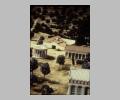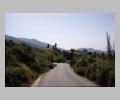
Model of sanctuary, showing Retaining wall of river Kladeos, from S

Model of sanctuary, showing Philippaion and Prytaneion, from southeast
| Summary: | Panhellenic sanctuary of Zeus, center of Olympic Games. |
| Type: | Sanctuary |
| Region: | Elis |
Periods:
Early Bronze Age
Middle Bronze Age
Late Bronze Age
Geometric
Archaic
Classical
Hellenistic
Roman
Physical:
In NW Peloponnese, at the confluence of Alpheios and Kladeos Rivers, Olympia sits in a fertile pastoral region surrounded by wooded rolling hills. A cult center since the Mycenaean period, the cult of Zeus was introduced in pre-Archaic times. Religious athletic games were reorganized in 776 BC and were held every 4 years until banned ca. 390 A.D. The sanctuary was constantly embellished during the thousand years of its existence to include temples, treasuries, bouleuterion, stadium, hippodrome, baths, dwellings for the priests and officials and accommodations for the pilgrims and athletes. There were thousands of altars, statues, decrees and votives in the temenos. The Altis or sacred grove, the temple of Hera, and the temple and altar of Zeus were the most important elements of the precinct. There were originally 2 and later 4 oracles.
Description:
There is evidence of settlement in the area of Olympia from the Early Bronze Age on, and although there is no archaeological proof for prehistoric cult activity at Olympia, tradition records that it was originally a place sacred to Ge, Cronus (the Mother of Gods), and Eileithyia as well as a cult center of the hero Pelops. At some time after the end of the Late Bronze Age the cult of Zeus was introduced and a walled sacred precinct was established.
At 776 B.C. (the date marking the beginning of the historical period) the religious games were reorganized and established as the Panhellenic Olympiads. Olympia developed rapidly and the sanctity of the sanctuary and the Olympic Truce (in effect for a short period every 4 years throughout Greece to protect pilgrims) were almost never violated.
During the Archaic period, the fame of the sanctuary grew and Greeks of the mainland and the colonies around the Mediterranean participated. The first monumental temple to Zeus and Hera was built in the second half of the 7th century B.C. and most of the treasuries were built in the 6th century and 1st half of the 5th century. The original Archaic stadium began at the Great Altar of Zeus and stretched along in front of the treasuries. In the following centuries, however, it was twice moved farther E, until, in the 4th century B.C., it reached its present location outside the sanctuary proper.
In the 5th century B.C. the sanctuary reached the peak of its fame. Olympia, however, remained predominantly a Greek cult center (in contrast to the Apollo sanctuaries at Delphi and Delos) and until the Roman period only Greeks were allowed to complete. At 470-456 B.C. the great temple of Zeus was built and housed the giant chryselephantine statue of Zeus (one of the 7 wonders of the ancient world).
Despite local wars in the later Classical period (Arkadia held Olympia from 364-362 B.C.), the fame and prosperity of the sanctuary continued to grow.
In the Hellenistic period construction in the center of the sanctuary was restricted to restoration and repair, but much new building activity took place outside the temenos to provide additional accommodations.
In 85 B.C. Sulla robbed the treasuries and held the 175th Olympiad at Rome. The sanctuary recovered its games and prestige in the time of Augustus, but the games were again interrupted in 69 A.D. to accommodate Nero. Although the Herulian barbarians did not reach Olympia, threat of their advance caused the Eleans to demolish some of the sanctuary buildings to build a fortification wall. The sanctuary continued to function in a poor manner and with minor restorations for another century. The end came with the decree of Theodosius prohibiting pagan worship.
Exploration:
Attention drawn to the site by Dr. Chandler in 1766 and by Winkelmann in 1768. Stanhope had a plan made of the site in 1829. First excavation and report by the French Expédition Scientifique de Morée in 1829. E. Curtius revived Winkelmann's plans for a restoration in 1852. Excavations: 1875-81, 1936-41, and 1952-present, German Archaeological Institute of Athens.
Sources Used:
Other Bibliography:



